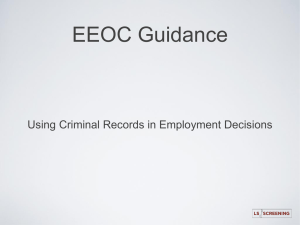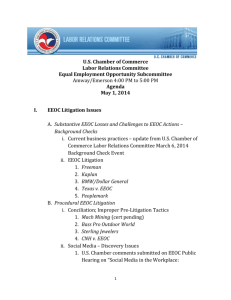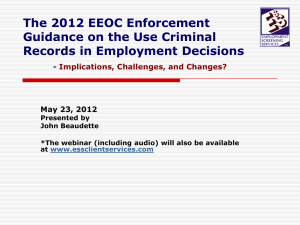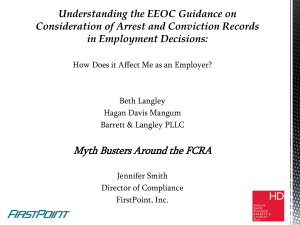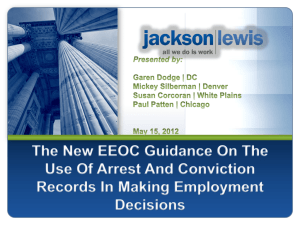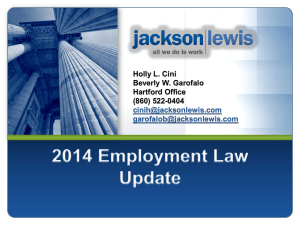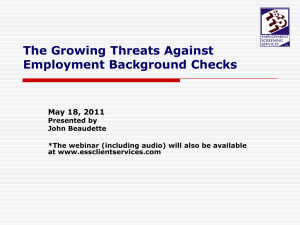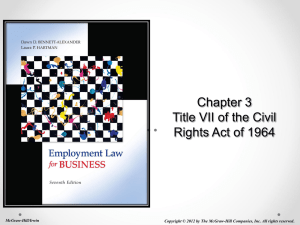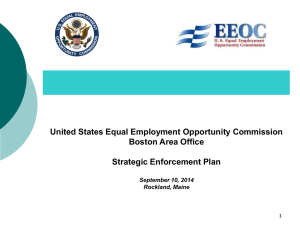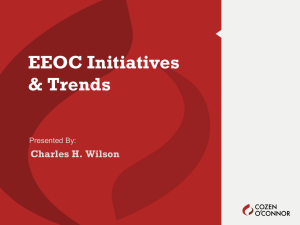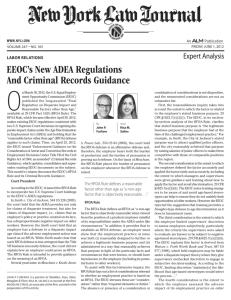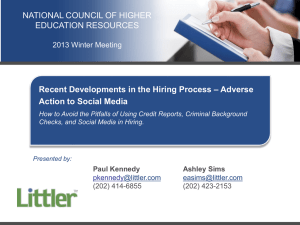Title VII requires that criminal record policies “accurately distinguish
advertisement
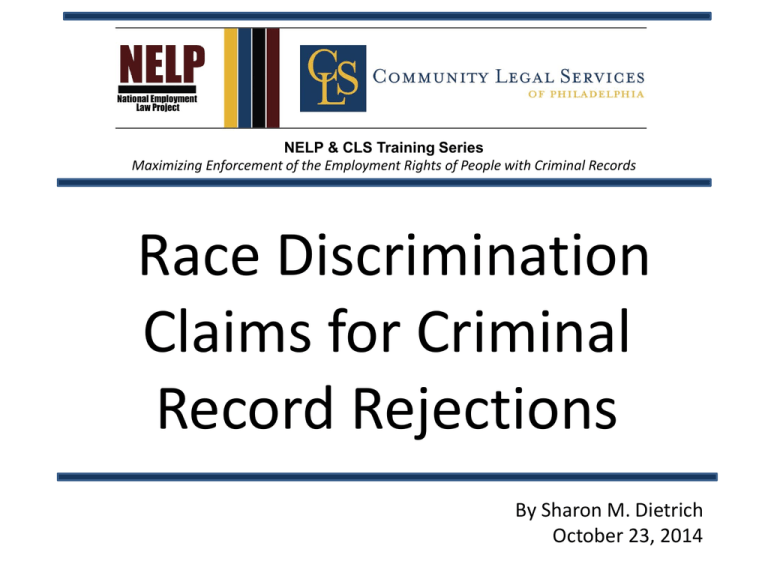
NELP & CLS Training Series Maximizing Enforcement of the Employment Rights of People with Criminal Records Race Discrimination Claims for Criminal Record Rejections By Sharon M. Dietrich October 23, 2014 Our Topics Today A short history of Title VII and criminal records; Highlights of the 2012 EEOC Guidance; Preparing and filing an EEOC charge, and handling of the charge by the EEOC; Different rules for federal jobs; A quick look at the materials. 2 A Short History of Title VII and Criminal Records Racially Disparate Impact and Criminal Records Because people of color are disproportionately represented in the criminal justice system, employer policies that exclude people with records have a disparate impact on people of color. Such policies must be justified by business necessity. Violates Title VII (federal antidiscrimination law) and can violate state/local laws. 4 Origins of Title VII Disparate Impact Adopted by the U.S. Supreme Court in Griggs v. Duke Power Co., 401 U.S. 424 (1971). Codified in Title VII in 1991, 42 U.S.C. §2000e2(k)(1)(A). Distinguished from disparate treatment cases – intentional discrimination. 5 Three Steps of Disp. Impact Analysis (1) a complaining party demonstrates that a respondent uses a particular employment practice that causes a disparate impact on the basis of race; (2) the respondent fails to demonstrate that the challenged practice is job related for the position in question and consistent with business necessity; and (3) the complaining party demonstrates an alternative employment practice and the respondent refuses to adopt such alternative employment practice. 6 Green v. Missouri Pacific Railroad Co. 523 F.2d 1290 (8th Cir.1975), on appeal after remand, 549 F.2d 1158 (8th Cir. 1977) Prohibited the automatic denial of employment based on a criminal conviction. Permitted the employer to consider convictions “so long as defendant takes into account the nature and gravity of the offense or offenses, the time that has passed since the conviction and/or completion of sentence, and the nature of the job for which the applicant has applied.” 7 3 EEOC Guidances Followed Convictions policy (1985)(Clarence Thomas) – adopted 3 Green factors. Proof of disparate impact (1987) Arrest records (1990) – Green factors, plus required review of conduct underlying arrest. “A blanket exclusion of people with arrest records will almost never withstand scrutiny.” 8 Then came a fallow period . . . True for disparate impact litigation in general, but also criminal records specifically. A notable decision: Field v. Orkin, No. 005913, 2001 WL 34368768 (E.D. Pa. Oct. 30, 2001)(applied Green analysis to white plaintiff). 9 El v. SEPTA 479 F.3d 232 (3d. Cir. 2007). Would not give deference to EEOC’s guidance – analysis was lacking. Title VII requires that criminal record policies “accurately distinguish between applicants that pose an unacceptable level of risk and those that do not.” Called for “some level of empirical proof that challenged hiring criteria accurately predicted job performance.” Plaintiff lost for lack of business necessity expert. 10 Highlights of the 2012 EEOC Guidance EEOC Enforcement Guidance Crucial new enforcement guidance approved on April 25, 2012. Subregulatory, so not controlling on courts, but probably entitled to deference. Certainly controlling on Commission. For more information, see Highlights of EEOC’s New Criminal Record Guidance (April 26, 2012) http:www.eeoc.gov/laws/guidance/upload/arrest_conviction.pdf 12 Title VII: Proof of Disparate Impact In a lawsuit, complex statistical evidence is required. Where does it come from? How is it analyzed? In the EEOC, disparate impact is presumed, need not be proved (Guidance, p. 10). Key reason EEOC charges are more feasible than litigation. 13 Title VII: Business Necessity & Arrests “An exclusion based on an arrest, in itself, is not job related and consistent with business necessity.” (Guidance, p. 12). An employer is supposed to evaluate the likelihood that the person engaged in the conduct for which s/he was arrested. 14 Title VII: Business Necessity & Convictions EEOC policy says that an employer is to consider the following factors: 1. The nature and gravity of the offense/conduct; 2. The time that has passed since the offense and/or the sentence completion; 3. The nature of the job held or sought. (Guidance, p. 15 - derived from Green). 15 Title VII: Matrices (“Targeted Exclusions”) Should take into account fact-based evidence, legal requirements, studies (p. 17). Guidance suggests employers should distinguish between different jobs and different offenses and provide time limits for disqualifications (see esp. Example 7, pp. 18-19). 16 Title VII: “Individualized Assessments” Not required, but strongly recommended to avoid liability. Process: Employer notifies applicant of possible rejection; Applicant has opportunity to respond; Employer considers what applicant said. (Guidance, p. 18). 17 Title VII: “Individualized Assessments” – Identified Factors Inaccurate information in record; Facts around criminal conduct; Number of offenses; Older age at time or conviction/release; Work history since conviction; Rehabilitation; References; Bonded. 18 Title VII and “Ban the Box” Guidance endorses the BTB principle of not asking about a criminal record on a job application as a best practice (Guidance, pp. 13-14). Should limit the number of applicants for which individual assessments are needed. 19 Title VII: Some Implications Across-the-board exclusions usually violate Title VII (p. 16). So does the firing of current employees who are performing well but have criminal records (see Example 8, p. 20). So do on-line applications that kick out people with a record (see Example 5, p. 16). 20 Preparing and Filing an EEOC Charge Strategy when Client has Title VII Claim File EEOC Charge. Cannot go to court without this. Fairly easy administrative procedure. And/or contact employer to explain law and demand job back. But don’t delay filing EEOC charge so long that miss deadline (180 or 300 days, depending on state)(But only 45 days for federal employment!) 22 Preliminaries under Title VII Employer must have 15 employees for jurisdiction Know your possible remedies! Injunctive relief (usually instatement or reinstatement) Lost wages Attorneys’ fees No compensatory or punitive damages for disparate impact! (Add a disparate treatment claim?) 23 Preparing an EEOC Charge – Identify Elements of the Story Collect info about the job opportunity lost because of the criminal record (do you know the employer’s policy?) Establish what client’s criminal record is. Identify the factors in the EEOC guidance that support the client (especially the Green factors). 24 Preparing an EEOC Charge – Prepare 3 Documents One-page charge form (only document given to employer). More detailed declaration setting out the facts. Cover letter – emphasize why the case is important; reference the Guidance and explain the legal theory. 25 Filing the EEOC Charge Identify your district office. Can be mailed in. File within either 180 or 300 days of knowledge of the rejection (depending on whether your state is a “deferral state.” 26 EEOC’s Response to Your Charge Expect lengthy delays! Investigation is mostly a remote, ex parte process. Some places may have fact-finding conferences, but doubtful. 27 EEOC’s Investigation They will ask the employer for a written response to the one-page charge (which you may or may not get). If they are serious about your charge, they will develop disparate impact data, using their systemic staff. Often subpoena fights with employers. They could mediate/try to settle the charge. 28 Outcome: “Finding” “Cause” – leads to formal conciliation, possible decision on whether EEOC or USDOJ would litigate; they can’t order anything. “No cause” – plaintiff has 90 days to file a lawsuit. Investigatory file can be “FOIAed” after a finding of no cause. 29 Title VII Litigation Should you take the case to court? That’s a commitment of a whole other magnitude. Cases are very expensive to litigate, and require experts. Work with private bar and others who have experience with such litigation. 30 Federal Jobs: A Different Ballgame Federal Jobs – Substantive Standards OPM establishes criteria for agencies to make “suitability” determinations – 5 CFR §731.202. If an agency finds someone “unsuitable,” that person can be barred for up to 3 years - 5 CFR §731.205. 32 Federal Jobs – Crazy Procedures Contact agency’s EEO counselor in 45 days. If no informal resolution, notice of failure; formal complaint must be filed in 15 days. Consider class allegations. Notice of final action – court action must be filed in 90 days. 33 A Quick Tour of the Materials Demand letters Sample EEOC charge materials Sample client education flyer 34
